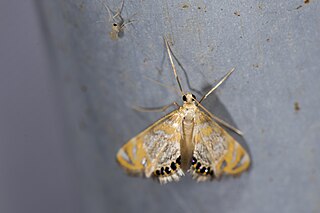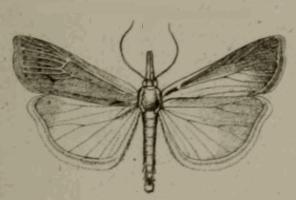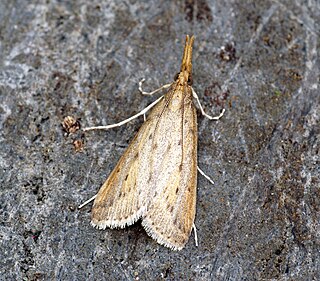
Crambidae comprises the grass moth family of lepidopterans. They are variable in appearance, with the nominal subfamily Crambinae taking up closely folded postures on grass stems where they are inconspicuous, while other subfamilies include brightly coloured and patterned insects that rest in wing-spread attitudes.

The Pyralidae, commonly called pyralid moths, snout moths or grass moths, are a family of Lepidoptera in the ditrysian superfamily Pyraloidea. In many classifications, the grass moths (Crambidae) are included in the Pyralidae as a subfamily, making the combined group one of the largest families in the Lepidoptera. The latest review by Eugene G. Munroe and Maria Alma Solis retain the Crambidae as a full family of Pyraloidea.

The Pyraloidea are a moth superfamily containing about 16,000 described species worldwide, and probably at least as many more remain to be described. They are generally fairly small moths, and as such, they have been traditionally associated with the paraphyletic Microlepidoptera.

Eoophyla is a genus of moths of the family Crambidae. It was erected by Charles Swinhoe in 1900.

Eristena is a genus of moths of the family Crambidae, found in southern and eastern Asia.
Micraglossa is a genus of moths of the family Crambidae.

Nymphicula is a genus of moths of the family Crambidae.

Paracymoriza is a genus of moths of the family Crambidae.

Parapoynx is a genus of moths of the family Crambidae described by Jacob Hübner in 1825.

Agriphila deliella is a species of moth of the family Crambidae. It is found in most of Europe and North Africa and from Anatolia to Afghanistan.
Udeoides is a genus of snout moths of the subfamily Spilomelinae in the family Crambidae. The genus was described by Koen Maes in 2006 and distinguished from the related genus Udea. All six species are distributed in the Afrotropical realm.

Agriphila tersellus is a species of moth in the family Crambidae. The species was described by Julius Lederer in 1855. It is found in Spain, Portugal, France, Italy, Austria, Croatia, Slovakia, Hungary, Romania, Bulgaria, Greece, Morocco, Algeria, Tunisia, Asia Minor, Turkmenistan, Syria, Lebanon, Iran and Transcaucasia.

Cybalomiinae is a subfamily of the lepidopteran family Crambidae. It was described by Hubert Marion in 1955.

Glaphyriinae is a subfamily of the lepidopteran family Crambidae. It was described by William Trowbridge Merrifield Forbes in 1923. The subfamily currently comprises 509 species in 75 genera.

Schoenobiinae is a subfamily of the lepidopteran family Crambidae. The subfamily was described by Philogène Auguste Joseph Duponchel in 1846.

Scopariinae is a subfamily of the lepidopteran family Crambidae. The subfamily was described by Achille Guenée in 1854.
Cosmopterosis thetysalis is a moth in the family Crambidae. It was described by Francis Walker in 1859. It is found from southern Venezuela and north-western Brazil north to the coast of Suriname and French Guiana.
Cosmopterosis spatha is a moth in the family Crambidae. It was described by Maria Alma Solis in 2009. It is found in Costa Rica, where it has been recorded from the provinces of Alajuela, Guanacaste, Limon and Puntarenas. It is found at altitudes between 50 and 1,600 meters.
Cosmopterosis jasonhalli is a moth in the family Crambidae. It was described by Maria Alma Solis in 2009. It is found from Sinaloa, Mexico, south to Paraguay, Peru and Venezuela. It is also found Trinidad and Tobago. It is found at elevations between 50 and 900 meters. Adults are on wing year round. The larvae feed on Capparis frondosa and Capparis flexuosa.
Erupinae is a subfamily of the lepidopteran family Crambidae. It was described by Eugene G. Munroe in 1995.











